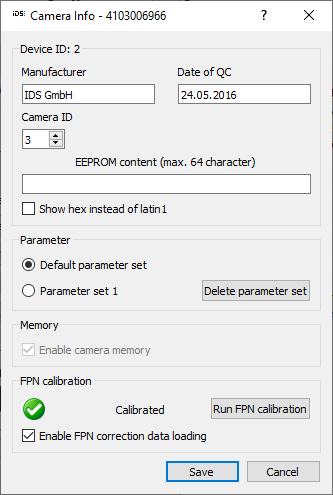IDS Software Suite 4.96.1
In the "Camera information" dialog box, you can assign a unique ID to the selected camera and write to the user area of the camera. The data you enter is retained in the camera memory even when the camera is disconnected from the PC or power supply.
|
You can only set the camera ID and write to the user memory if the camera is marked "Free" and "Available" in the IDS Camera Manager (see also Camera list). |

Fig. 91: IDS Camera Manager – Camera information
The "Camera information" dialog box displays various, non-editable camera information:
•Manufacturer (e.g. IDS Imaging Development Systems GmbH)
•Date of QC (date of final camera quality test)
The camera ID identifies a camera in multi-camera operation. You can assign IDs in a range from 1 to 254. The default value for the camera ID is 1. The same ID can be assigned to multiple cameras. You do not have to assign sequential ID numbers to all connected cameras.
•If software accesses cameras through the uEye DirectShow interface, the camera IDs must be in a range from 1 to 24.
•If software accesses cameras through the uEye Cognex VisionPro interface, the camera IDs must be assigned consecutively beginning with 1.
EEPROM content
Every uEye camera has a non-volatile user memory. Besides the hard-coded factory information, the user memory of the uEye camera can hold additional user data which is not to be stored cyclically but permanently.
Parameter
Here, you can set whether to apply the parameters stored on the camera automatically when opening the camera. You must first store the camera parameters on the camera using the is_ParameterSet() function or via the corresponding function in the uEye Cockpit.
This setting applies to all connected cameras. If no parameters are stored on the camera, the standard parameters of this camera model are applied (see also is_Configuration()).
Memory (USB 3 uEye CP Rev. 2 only)
Enables/disables the internal image memory of the camera, see is_DeviceFeature().
|
From IDS Software Suite 4.81 on, the camera is operated with active image memory by default. Deactivation of the image memory is not possible any more. If you check the "Compatibility mode" option in the Additional functions, you can disable the internal image memory again. This corresponds to the camera behavior up to and including IDS Software Suite 4.80.2. See "Image memory compatibility mode". Note that you need administrative privileges to configure the image memory. |
•Note that the camera has to be closed if you enable or disable the image memory.
•When you enable or disable the internal image memory, the camera is connected again. Therefore, the camera is briefly not visible in the camera list of the IDS Camera Manager.
•For some USB 3 uEye cameras, you must activate the image memory to operate thema on a USB 2.0 port, see Camera and sensor data.
•If the image memory is activated the cameras can be operated with a higher pixel clock and frame rate. Temporary CPU loads are therefore compensated.
•Note that higher camera pixel clocks causes a higher power consumption. Therefore, provide sufficient heat dissipation, see Ambient conditions USB 3 uEye CP Rev. 2.
FPN Calibration (UI-313x, UI-314x, UI-316x and UI-318x only)
The FPN calibration can be done for camera models that are not factory-calibrated. This function is disabled for factory-calibrated cameras. Depending on the hardware, the FPN calibration can take several minutes while the CPU-load increases accordingly. To calibrate a camera that is not factory-calibrated, read the Application Note "FPN calibration (UI-3130CP Rev. 2, UI-3140CP Rev. 2, UI-3160CP Rev. 2, and UI-3180CP Rev. 2)".
To open a calibrated camera takes longer because the FPN correction data has to be loaded. Via the "Enable FPN correction data loading" option, you can define for each camera if the FPN correction data is loaded and therefore, the FPN correction is activated.
